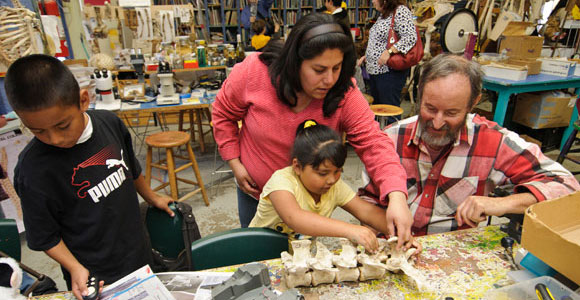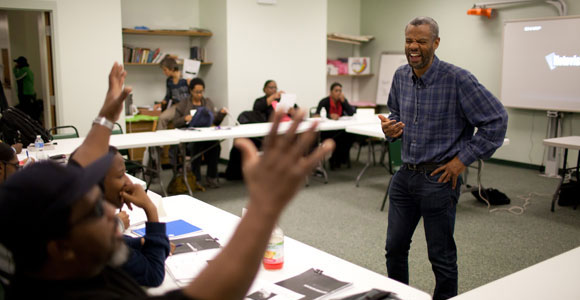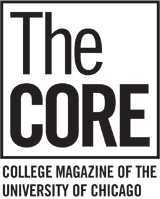
Free Thinking
In San Francisco and Chicago, College alumni transform education through programs that are innovative, old-fashioned, and free.
by Carrie Golus, AB’91, AM’93 | Photography by Jay Watson and Jason Smith
SATURDAY, OCTOBER 8, 11 A.M.
MISSION SCIENCE WORKSHOP
18TH AND CHURCH STREETS, SAN FRANCISCO
“If you can talk you can sing”
“If you can walk you can dance”
“If you can wonder you can learn”
—Handwritten sign at the Mission Science Workshop
There’s a four-foot ball python around somewhere.
The Mission Science Workshop is packed with kids and parents here for its Family Science Open House. But nobody seems particularly worried about the rogue python, which escapes with some regularity.
Once it was discovered underneath the human skeleton; another time, on top of the drill press. “If you find Monty, please let us know,” reads a message on the whiteboard, which also lists “Today’s Specials”: free T-shirts for kids, a hair weight contest on the milligram balance, and “take apart printers, fax machines, etc.”
The noise level is incredible. Children are banging on drums, running sticks over piano strings, turning an air compressor on and off, chattering to each other through tubes hanging from the ceiling. Excited calls of “Mom! Mom!” come from several directions at once.
The parents, mostly Spanish speaking, seem as excited as the kids. The monthly event at Mission Science Workshop—named for the Mission, a predominantly Latino neighborhood in San Francisco—is free and open to all, but advertised only in Spanish.
At one table, Keilani Diaz Moreno, 6, has dumped out a box of animal vertebrae. Dan Sudran, AB’66, the workshop’s founder, stops to explain to her in Spanish how a cow’s spine fits together. Bone by bone, Keilani clicks the spine into place. She gently pokes her mother in the stomach to get her attention, then slaps Sudran a high five.
At another table, kids are building vehicles out of scrap wood. Victor Pena, 5, enthusiastically shows Sudran his creation: “It’s a car with a sail!” As they finish, the kids take their cars outside and roll them down a wheelchair ramp.
Meanwhile Jeffery Soto, 9, walks over to the human skeleton, barely taller than he is, and shakes its hand. “You can’t get those anymore,” Sudran notes. “They’re expensive. I think maybe illegal.”
SUDRAN IS NOT a trained scientist. In school, he hated science: “I had a horrible high school physics class that turned me off for years.” He continued to hate science at UChicago, where he majored in history. He later went to law school but failed the bar exam twice. Realizing he didn’t want to be a lawyer, he took a job as an organizer with the United Farm Workers Union.
In 1981, Sudran became an electronics technician at City College of San Francisco. The job “stimulated my curiosity about how things work,” says Sudran, “which came to include nature in general, not just human technology and inventions.” Thus began an unexpected love affair with science: “All of a sudden it came to life for me.”
So, like a gentleman scientist from centuries ago, around 1990 he set up a workshop in his garage, where he began to tinker with electronics and collect rocks, bones, and fossils. “I had a coyote in my freezer,” he recalls, “and roadkill drying in my backyard.” The neighborhood kids would wander in to see what he was doing, and Sudran, who was raised bilingual, realized he enjoyed showing them.
Two decades later, the workshop is based in the former auto technology shop at Mission High School. More than 250 children a week visit on field trips. It offers after-school workshops and a six-week-long “summer scientists” program.
The delightfully disorganized room retains the feel of a garage workshop, with battered maps, salvaged equipment, and Sudran’s quirky hand-lettered signs everywhere. A sign on a sea horse display reads “male (with egg pouch!!)” Another explains tree rings: “These trees fell in 2009. Count back to the center to see when they were BORN!”
ANIMALS ARE WONDERFUL therapy,” says Sudran. “Holding a snake is a very effective meditation aid.”
The animal area is the one heavily regulated zone in the otherwise laissez-faire science playground. Kids are allowed to handle any of the animals—ball pythons (Monty and Tiny), corn snakes (Blanca and Cornelia), a leopard gecko (Mango), a blue-tongued skink (Maurice), a toad (Ihop), an iguana (Spike), two bearded dragons (Spazz and Harvey), and a tarantula (Aaron)— as long as they follow the posted “Rules for Animal Time.”
These include “No scaring people with animals” and “Keep away from face aka—No snakes around neck.” A maximum of four kids are allowed; each kid must sit in a chair and hold the animal with both hands. There’s a simple reason for the sitting and two-hands rules. “We’ve had animals die before, when people got scared and threw it,” says teacher Aaron Martin.
“Want to hold one?” Martin asks Danna Ruiz, 7. She smiles and shakes her head no; her brother, Jonathan, 15, says yes to a python. “I’m surprised,” says their father, Adan Ruiz.
Danna is clearly fascinated. As Martin talks to her in Spanish, she works up the courage to stroke the snake’s skin gently. Danna’s mother, Claudia Enriques, agrees to hold the skink; when she hands it back, she shivers all over.
The family tries out a few other activities, but not much later, Danna is back at the animal station. This time, she’s ready. Martin places the coiled python into her hands; it stretches out its neck and slithers gracefully around her wrist. Danna smiles.
I’M 67 YEARS OLD,” says Sudran. “I tell the kids, if it wasn’t for you, I’d be retired and bored as hell.”
In fact he’s busier than ever. When a whale carcass washed up on Pescadero State Beach last year, Sudran claimed part of its skeleton for a nearby elementary school. In December, he opened a new science workshop in the old City Hall in Greenfield, a poor Mexican-American community south of Salinas. And he’s developing a take-home science kit that will allow kids to learn about “the thermodynamics of water,” he says. The components of the kit: a thermometer, a clear ruler, and two plastic cups.
Sudran still considers himself an organizer as much as a teacher: “probably 60 percent organizer, 40 percent science educator,” he says. During his four years at the Farmworkers Union, he developed the patience and stamina to motivate people “who may not at first get the point of what we are doing,” he says. Without that, “the most exciting science curriculum may not go anywhere.”
Behind all of Sudran’s projects is the idea that adults should cut out the “teacher talk” and let kids try to figure things out themselves—even if they come up with the wrong answer. “The most important things in science are the questions. You can’t get to the answer without the question,” he says. “Explanations are very overrated.”

THURSDAY, OCTOBER 27, 6 P.M.
AKARAMA FOUNDATION
62ND AND INGLESIDE, CHICAGO
“You can change your life. You can get the education you’ve always wanted.”
—Flyer for Odyssey Project Chicago
OUTSIDE, IT’S DARK. Inside, the lights are all off except one, so that Hamza Walker, AB’88, can use his laptop to project images on the wall: right now, a coin collection. His art history class tonight centers on the origin of museums, as well as “the art-culture system,” in the term of anthropologist James Clifford.
Two and a half minutes into Walker’s lecture, Honni Harris asks her first question: “Do you collect?”
Walker, whose day job is associate curator and director of education at the Renaissance Society, the contemporary art museum based in Cobb Hall, considers. “I’d like to say no, but that’s probably not true,” he says. “I’m lying to you right now.” The ten other students in the class laugh.
“I know you are,” says Harris. The students laugh harder.
“I have some art,” Walker admits finally. “I have bric-a-brac. I have sentimental bric-a-brac around which I configure meaning.”
THIS SEMEMSTER MARKS the first time Walker has taught a class for the Odyssey Project, run jointly by the Humanities Division’s Civic Knowledge Project and the Illinois Humanities Council. It’s part of a nationwide program, the Clemente Course in the Humanities, founded by author Earl Shorris, X’53, winner of the National Humanities Medal.
The idea behind the Clemente Course is old-fashioned, yet deeply radical: that education in the humanities can provide a pathway out of poverty. The yearlong course, open to adults earning up to 150 percent of the poverty level, costs nothing. Books and transportation are paid for; child care is provided on-site.
Shorris studied at the College during the Hutchins era, and the course—with its intriguing mixture of elitism and populism—was profoundly affected by the thinking of that time. “The philosophy of the Clemente Course,” Shorris explained in a 2000 interview with Mass Humanities magazine, “grows out of an idea put forth by Robert Maynard Hutchins: ‘The best education for the best is the best education for all.’”
As well as art history, students take literature (taught by Adam Davis, PhD’03), philosophy (taught by Charles Thomas Elder, AM’83, PhD’91, who also teaches in the social sciences core), US history (taught by Hana Layson, AM’95, PhD’03), and critical thinking and writing (taught by Amy Thomas Elder, X’84, the program’s administrator). Students who complete the program earn six hours of college credit.
ON AN EASEL PAD, Walker redraws Clifford’s diagram “The Art-Culture System: A Machine for Making Authenticity” from The Predicament of Culture (1988). To prepare for tonight’s class, students had to slog their way through the chapter “On Collecting Art and Culture.”
The diamond-shaped diagram places “authentic” at the top, “inauthentic” at the bottom; “artifact” on the right, “masterpiece” on the left. Clifford’s interest—and Walker’s—is how objects move from one zone to another: in particular, how folk art or objects from non-Western cultures come to be considered high art.
Turning back to his laptop, Walker shows the class an example of folk art that has made the transition to high art: crazy quilts from Gee’s Bend, Alabama.
Unlike quilts made by a group of women working together around a table, “crazy quilts are the work of a lone woman, working with scraps, stitching on her lap, so the patterns become skewed,” Walker explains.
“Crazy quilts from Gee’s Bend are considered special because they’re part of a continuing tradition that goes back into slavery, to African textiles,” he says. “And they look like modern geometric abstractions, on par with the great paintings of the 20th century.” On Clifford’s diagram, the quilts had moved from zone 2 (authentic, artifact) to zone 1 (authentic, masterpiece).
“I like that one,” says Harris of a quilt that looks like Op Art.
“That’s hypotizing me, man,” says Virgil Burgs.
“My grandma would have made something like that,” says Andre Wilson. “I wouldn’t put it on the wall. But it will keep you warm.”
Walker laughs. “I like that,” he says. “You are talking to a man who slept under a moving blanket my first year in college.”
THE MOST OBVIOUS criticism that could be leveled at the Odyssey Program—and it has been leveled against the study of the humanities many times—is that it is impractical. If you are poor, why sit around philosophizing about the art-culture system? Wouldn’t it be wiser to get some kind of practical, job-related training?
But training is even more impractical, according to Shorris. It prepares students for jobs that are “poorly paid, with little or no chance for advancement,” he said in the 2000 interview.
“If one has been ‘trained’ in the ways of poverty … what is needed is a beginning, not a repetition. The humanities teach us to think reflectively, to begin, to deal with the new as it occurs to us, to dare. If the multigenerational poor are to make the leap out of poverty, it will require a new kind of thinking—reflection.”
It’s a beautiful argument; perhaps he’s even right.
The students themselves have more limited expectations. Philisha Carter works two part-time jobs: conducting telephone surveys for NORC and providing homework help for an after-school program. “I know a lot of people with college degrees, and they’re doing what I’m doing,” says Carter, who brings her three children—Malik, 14; James, 11; and Jeremiah, 7—to class with her. “I want a college degree for myself. It’s for my own self-worth, and to encourage my kids.”
Harris’s view is similar. “I always loved learning,” she says, but in high school, divided into “the haves and the have-nots,” she felt like the teachers overlooked the have-nots. She dropped out of Kenwood Academy her junior year.
“I’ve always been opinionated. This is the first time that’s been looked upon as something good,” she says. “If President Obama was sitting right there, I wouldn’t be intimidated to discuss Socrates with him. Socrates is my new best friend.”
Harris’s oldest son Edward, 17, is now a senior at Kenwood. As well as taking Odyssey classes, she’s studying furiously for her GED: “I want to get my degree,” she says, “before he gets his.”
NEXT WALKER SHOWS photos of Shaker furniture, one of Clifford’s examples of a craft now categorized as high art. Shaker furniture, like modern furniture, is known for “elegance, simplicity, and excellent craftsmanship,” Walker explains. “But from their point of view, it comes from living a life without any frills.” The students nod. “It’s not a collector base for Shaker furniture—it’s a cult. Oprah was buying so much, she was single-handedly driving prices up.”
Walker flips through images of benches and chairs. “Lovely,” several students say.
“Let me ask you a question,” says Harris. “Is it expensive because of the craftsmanship, or because it goes back to their tradition, or both? Why should I have to pay for their tradition?” The class laughs explosively. “What if I really don’t care about them or agree with them? Why is that added on?”
“This is a fabulous question. This is an incredible question,” says Walker.
“What you’re saying is actually implicit in Clifford’s argument. This chair is an expression of the Shakers. It is of them, it is them,” he says. “A similar modernist one—that’s just a good piece of furniture. It doesn’t express the collective religious aspirations and way of life of a people. For that, you gotta pay more.”
“Those quilts are lovely, but who says they’re art?” says Harris. “I think art is personal. No one should be allowed to say what’s art and what’s not.”
“So you’re trying to put me out of a job,” says Walker, who in 2010 won the Ordway Prize, one of the art world’s most prestigious awards, for his innovative curatorial work. “That’s okay, I’m not going to take that personally.” His students are laughing again.
THE CLASS CONTINUES into its second hour with no break. A few people have brought snacks—cheese puffs, potato chips—which they manage to eat with a noteworthy lack of crunching. Despite the evening hour and the dark room, not a single student is slumping or yawning.
Next week, Walker plans to take the students on a field trip to the Art Institute. Tonight, it’s a virtual tour, beginning at the website of the Museum of Modern Art (“Where is that again?” Wilson wants to know; “New York,” says Walker), stopping off at Toronto’s Bata Shoe Museum, and ending at the National Firearms Museum in Fairfax, Virginia.
“The reason I like Clifford is that he reveals the assumptions we have when we go into a museum,” Walker says. “When we go to the Art Institute, you’ll see there’s China, pre-Colombia, Africa, Oceania. We have this idea that all cultures are capable of producing beauty. But that wasn’t the case 100 years ago, when ethnographic objects were displayed as curiosities.”
At the end of class, Walker retells a story from the Clifford book, about anthropologist Claude Lévi-Strauss and his surrealist artist friends in New York in the 1940s. Passionate collectors, they bought up Eskimo masks from the Bronx warehouse of the Museum of the American Indian. The museum’s director considered the masks “jokes” and sold them for tiny sums. “The Surrealists bought the best,” Walker reads from the book, “…stripping it of one masterwork after another.” Recently, he says, one of these masks came on the market and sold for $2 million.
“The museum director completely undervalued them,” says Walker. “Not in his wildest dreams, clearly, did he ever see these things as having value. He didn’t give them any respect.” The students nod; the idea of being undervalued seems to have a particular resonance.
At 8 p.m., they begin putting away notebooks and pulling on coats. A few of the students drive to class or get rides, but most take public transit home.
As the other students drift away, Harris lingers in the classroom to keep talking with Walker about museums. She might end up waiting longer on the El platform, but she’s been waiting a long time—decades, in fact—to have discussions like this.
